Related Research Articles

Saxe-Coburg and Gotha, or Saxe-Coburg-Gotha, was an Ernestine, Thuringian duchy ruled by a branch of the House of Wettin, consisting of territories in the present-day states of Thuringia and Bavaria in Germany. It lasted from 1826 to 1918. In November 1918, Charles Edward, Duke of Saxe-Coburg and Gotha, was forced to abdicate. In 1920, the northern part of the duchy was merged with six other Thuringian free states to form the Free State of Thuringia: Saxe-Weimar-Eisenach, Saxe-Altenburg and Saxe-Meiningen, Schwarzburg-Rudolstadt and Schwarzburg-Sondershausen, as well as the People's State of Reuss. The southern part of the duchy, as southernmost of the Thuringian states, was the only one which, after a referendum, became part of the Free State of Bavaria.
Schmalkalden-Meiningen is a Landkreis in the southwest of Thuringia, Germany. Its neighboring districts are the districts Wartburgkreis, Gotha, Ilm-Kreis, the district-free city Suhl, the district Hildburghausen, the Bavarian district Rhön-Grabfeld, and the district Fulda in Hesse.
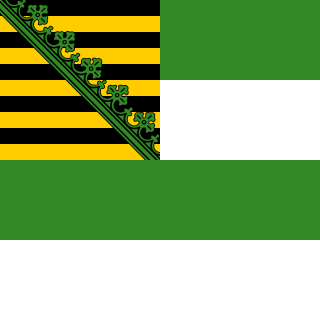
Saxe-Meiningen was one of the Saxon duchies held by the Ernestine line of the Wettin dynasty, located in the southwest of the present-day German state of Thuringia.

Saxe-Coburg-Saalfeld was one of the Saxon Duchies held by the Ernestine line of the Wettin Dynasty. Established in 1699, the Saxe-Coburg-Saalfield line lasted until the reshuffle of the Ernestine territories that occurred following the extinction of the Saxe-Gotha line in 1825, in which the Saxe-Coburg-Saalfeld line received Gotha, but lost Saalfeld to Saxe-Meiningen.
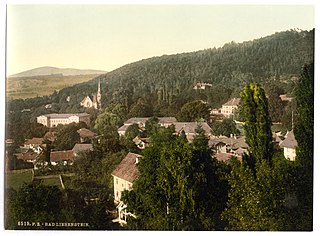
Bad Liebenstein is a municipality and spa town in Wartburgkreis district of Thuringia, Germany.

Ernst Ludwig I, Duke of Saxe-Meiningen was a German (Saxon) nobleman.

Ernest Frederick I, Duke of Saxe-Hildburghausen, was a duke of Saxe-Hildburghausen.

Anton Ulrich, Duke of Saxe-Meiningen, was Duke of Saxe-Meiningen from 1746 to 1763.

Georg II, Duke of Saxe-Meiningen, was the penultimate Duke of Saxe-Meiningen, reigning from 1866 to 1914. For his support for his successful court theatre he was also known as the Theaterherzog.
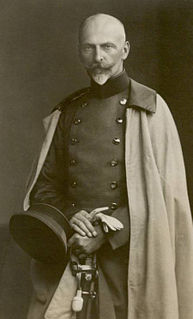
Prince Friedrich of Saxe-Meiningen, Duke of Saxony was a German soldier and member of the Ducal House of Saxe-Meiningen.
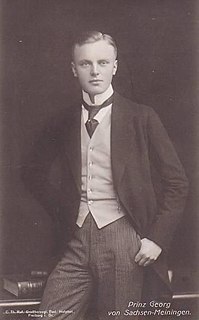
Georg, Prince of Saxe-Meiningen was the head of the house of Saxe-Meiningen from 1941 until his death.

Saxe-Gotha-Altenburg was a duchy ruled by the Ernestine branch of the House of Wettin in today's Thuringia, Germany. The extinction of the line in 1825 led to a major re-organisation of the Thuringian states.

Elisabeth Sophie of Saxe-Altenburg, was a princess of Saxe-Altenburg and, by marriage, duchess of Saxe-Gotha.

Henneberg was a medieval German comital family (Grafen) which from the 11th century onwards held large territories in the Duchy of Franconia. Their county was raised to a princely county in 1310.
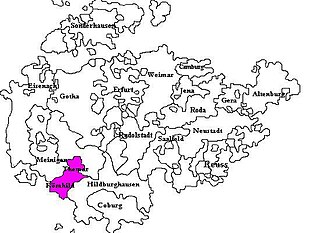
Saxe-Römhild was an Ernestine duchy in the southern foothills of the Thuringian Forest. It existed for only 30 years, from 1680 to 1710.

The Thuringian states refers to the following German federal states within the German Reich:
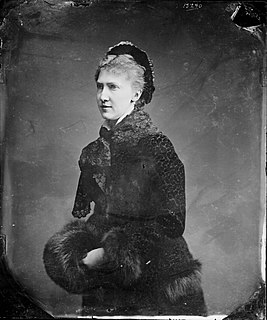
Princess Augusta of Saxe-Meiningen was the daughter of Bernhard II, Duke of Saxe-Meiningen and his wife Princess Marie Frederica of Hesse-Kassel. She was the mother of Ernst II, Duke of Saxe-Altenburg.

Princess Charlotte of Saxe-Meiningen was a member of the House of Saxe-Meiningen and a Princess of Saxe-Meiningen by birth and a member of the House of Saxe-Gotha-Altenburg and Duchess consort of Saxe-Gotha-Altenburg through her marriage to Ernest II, Duke of Saxe-Gotha-Altenburg.
Events from the year 1880 in Germany.

Marie Hedwig of Hesse-Darmstadt was a landgravine of Hesse-Darmstadt by birth and by marriage Duchess of Saxe-Meiningen.
References
- 1 2 Gonschior, Andreas. "Der Volksstaat Sachsen-Meiningen Landtagswahl 1919". Wahlen in der Weimarer Republik. Archived from the original on 2003-05-11. Retrieved 18 May 2021.